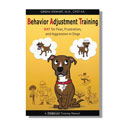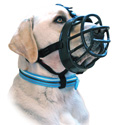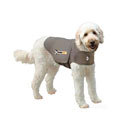Some dogs will charge and bark aggressively at any dogs walked in front of their kennel indoors or at outdoor edges of their kennel. It is seeing the other dog moving closer that triggers the barrier aggression. Very likely these dogs were left alone many hours fenced or tied in locations where they were often stimulated visually by people and other dogs. Along with clicking for not barking and for not jumping up on the front of the kennel, UVHS has added nylon fabric panels to cover the chain link panel of the offending dog's kennel door. The panels are hooked to the chain link and can be removed as the dog develops self control which will happen as your clicker wise shelter staff and volunteers reinforce for calm, quiet, and not jumping up.
We also use nylon panels between outdoor kennel runs and at the back of the run so other dogs can walk by and not be seen from the kennel run.
You may find someone locally - perhaps a volunteer - who can sew the panels and add grommet holes in the 4 corners (and on any long side). You can then attach the panels to the outside of the chain link with the metal shower curtain clips or cord. [We use Paula Harper who has a mail order business supplying agility tunnel chutes and other sewn dog related products. She puts plastic clips on her nylon panels that work well and won't rust. You may contact her at:603-485-3379 or e-mail to pjh59 [at] aol [dot] com]
Now with the panel in place, when you walk by with a dog on leash (we also use gentle leaders on all our shelter dogs) the barrier aggressive dog will be able to tolerate the leashed dog. The person is walking between the leashed dog and the kenneled dog to further reduce the stress on both dogs. A staff member or volunteer standing nearby will click and chuck food for moments of nonreactive looking. After the click the treat can be tossed in over the top of the kennel so the handler can keep walking by calmly. Soon the barrier aggressive dog will be coming up to see who is there to provide treats. When the behavior has begun to diminish, the top of the panel can be clipped half way down to help the barrier aggressive dog tolerate seeing part of the leashed dog. A half panel barrier allows some visual contact with the person, but keeps the dog on leash partially covered. It's very important to be offering lots of clicks and tossed treats for looking, but not barking. The final step is to remove the panel, lowering it a bit at a time. If the behavior starts up again, then just place the panel back where it was working. And perfection would be when you can stop with a dog on leash and reward the previously barrier aggressive dog for his wonderful good manners!
For the newly arrived quarantined dogs at the Upper Valley Humane Society we use the external nylon panels (or all weather tarps) around the entire outside of their kennels. Because these dogs are so challenged by the new environment we want to create as much psychological safety as possible. In this part of the shelter many fewer dogs are walked in the aisles, so front panels are only used for the very stimulated dogs. By the time dogs are moved to the adoptable side they no longer need the panels and have learned not to bark for attention, but to sit and wait for clicks and treats.
Nylon panels are a very inexpensive way to convert any kennel into a psychologically safer learning environment for the shelter dogs.
Note: We also use the kennel door panel for those shy dogs that folks keep trying to make friends with by bending over and staring at the dog. We found that placing the panel up high and leaving about two to three feet of visible chain link at the bottom of the door, then people had to squat down to peek in. Lo and behold, the shy dogs would then approach. This happened by accident when one of our nylon panels was too short, but when we saw what was happening it became a part of every shy dog's front kennel door. This has been a huge success. It also gives us a chance to compliment the person who had to kneel, on how much their approach is helping the dog and why.
Contact Dee Ganley, UVHS Training Center Manager and Behavior Counselor with any questions at 603-488-6888 ext. 103 or e-mail dee [at] UVHS [dot] org. For more information on the Upper Valley Humane Society their web site is at www.UVHS.org.
Copyright © 2002 Upper Valley Humane Society







Barriers for Aggression
We recently placed covers over the doors of one row in our Shelter. The row was quieter and there were no longer battles every time a dog was moved from his kennel. However, we also noticed that the dogs now sit directly behind the door, covered with a 40" high cloth barrier, and potential adopters cannot see them.
Anyone experiences this? Have a fix?
Thanks.
Post new comment